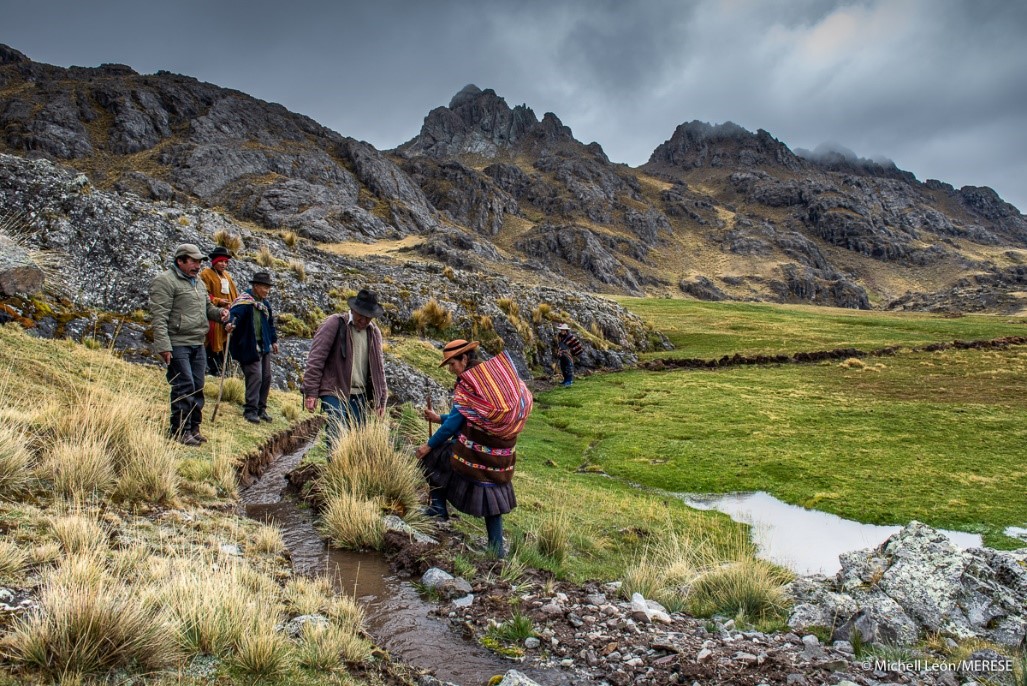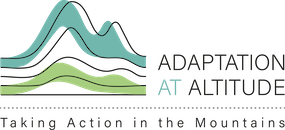Mechanisms for ecosystem services retribution in the Cañete river basin, Peru (MERESE)

Summary
This project implemented by the Minister of Environment of Peru (MINAM) and the International Fund for Agricultural Development (IFAD) seek to conserve and protect 9,482 hectares of native forests, grasslands and wetlands in the Cañete river basin, Peru.
In the Cañete river basin, located in the Nor Yauyos Cochas reserve, are being implemented mechanisms for hydro-ecosystem services retribution (MERESE), as an innovative scheme to involve lower basin actors in the funding of conservation practices in the upper basin and key watersheds areas.
The MERESE-FIDA Project, “Conservation and Sustainable Use of High Andean Ecosystems of Peru through Payment for Environmental Services for the Relief of Rural Poverty and Social Inclusion” is currently being developed in the basin through the design of MERESE schemes. This project is implemented by the Minister of Environment of Peru (MINAM) and the International Fund for Agricultural Development (IFAD). The financial resources are administered by the Fund for the Promotion of Protected Natural Areas of Peru (PROFONANPE). It involves the protection of 13,805 ha 23,866 ha of high Andean ecosystems and landscapes, as well as the formation of one trust fund whose profitability will cover the expenses related to the monitoring and evaluation of the project for the benefit of more than 1,579 families in the Jequetepeque and Cañete river basins. The protection of the high Andean ecosystems and landscapes will be reached by financing subprojects for the conservation and sustainable use of ecosystem services undertaken by local communal groups, as well as through the design and implementation of the MERESE schemes.
The Nor Yauyos Cochas Landscape Reserve (RPNYC) was created on May 1, 2001, through Supreme Decree No. 033-2001-AG. The RPNYC is located in the upper and middle basin of the Cañete river and in the Cochas Pachacayo basin in the highlands of the Lima and Junín departments. It has an area of 221,268.48 ha.
As a result of the project, a total of 9,482 hectares of native forests, grasslands and wetlands are being recovered and conserved in the Cañete river basin, 5,893 of which are within the RPNYC, thanks to the work coordinated between the MINAM, the National Service of Protected Natural Areas (SERNANP) and 17 that inhabit that territory. The upper basin groups are mainly peasant communities dedicated to agriculture, livestock and fish farming. In the rural district of Miraflores, the population has recovered pre-Inca structures to improve the irrigation of the pastures and thus efficiently feed the cattle, which represent their main source of income. There are 80 families that are dedicated to livestock and that, through the sowing and harvesting of water, have managed to cope with the drought, a product of the CC.
The Cañete river basin is located on the central coast of Peru, has a total area of 601,734 km² and an extension of 235 km from its source in the Ticllacocha lagoon, located in the rural community of Tanta, to its mouth in the Pacific Ocean. About 80% of the area of the basin is located above 2,500 meters above sea level. The basin is located in the Lima region, extending through the provinces of Yauyos, Cañete, and Huarochirí.
The RPNYC is the first landscape reserve in the country, where 16 peasant communities live in and in the buffer zone. The landscape reserve category, according to the IUCN, seeks the articulation between man and nature, and has a landscape modelled by man through pre-Inca terraces, crops, ancestral customs and a set of canals. The predominant activities are agricultural and livestock production based on ecosystem management.
In the territory of the upper basin of the Cañete river there is also mining activity and a reservoir for the operation of the Compañía Eléctrica El Platanal S.A. (CELEPSA) located in the lower basin. Mining activity dates back to the decade of the 1980s and is concentrated in two peasant communities. This activity has generated various conflicts between communities and companies (Tristán Febres, 2020). For its part, the construction of CELEPSA’s Paucarcocha reservoir meant a series of negotiations with the peasant community of Tanta. This water infrastructure transformed part of the community’s territory, occupying natural pasture areas where livestock is the central activity. Currently, CELEPSA is part of the RPNYC Board of Trustees, which is an initiative that involves private companies aimed at generating and financing actions for conservation, environmental management, and sustainable development.
For its part, the lower basin concentrates the largest amount of population and demand for water resources. The entity in charge of supplying drinking water is the Municipal Potable Water and Sewerage Company Cañete (EMAPA), which supplies twelve districts. In this part of the territory, the main economic activity is intensive agriculture, very different from that developed in the upper basin, which is small agriculture for self-consumption. In the lower basin, the agricultural production of the Cañete valley is oriented mainly to the market, where there is an important growth in crops for export.
Protected natural area plays a key role in CC adaptation and mitigation, highlighting the importance of the management and contribution of the water ecosystem service of the Reserve to the Cañete, Mantaro river basins (Sub basins of the rivers Cochas-Pachacayo, Canipaco, Cunas and Huari), Rímac and Mala. The conservation and development of the most important productive activities such as livestock, agriculture, fish farming and tourism in an orderly manner without altering the ecosystem and cultural balance, as well as the recovery of agrobiodiversity and its Andean crops such as native potatoes, mashua, oca, corn and beans in agroecosystem areas (platforms and terraces) are other important points included in the master plan. Likewise, it seeks to make the Reserve an important ecotourism destination with diversified products and quality services.
Overview
- Location:
- Implementation sites:
-
- Single country
- Multiple locations
- Mountain region:
-
Andes
- Province:
-
- Department of Lima
- Site locations:
-
Comunidad Campesina de Madeán, Comunidad Campesina de Huantán, Comunidad Campesina de Laraos, Comunidad Campesina de San Lorenzo de Alis, Comunidad Campesina de Tayamarca, Comunidad Campesina de Auco, Comunidad Campesina de Carania, Comunidad Campesina de Pampas, Comunidad Campesina de Tomas, Comunidad Campesina de Miraflores, Comunidad Campesina de Huancaya, Comunidad Campesina de Tanta, Comunidad Campesina de Ortigal, Comunidad Campesina de Tinco, Asociación Ecoturística Artesanal Vilca Yauyos, Comunidad Campesina de Quisque, Comunidad Campesina de Vitis.
- Solution scale:
- Area Covered:
-
- 2210 km2
- Ecosystem type(s):
- Solution type(s):
- Sector(s):
- Climate impact(s) addressed:
- Other climate impact(s) addressed:
-
- soil and biodiversity degradation
- Climate impact time-scale(s):
- Main benefit associated with the solution:
- Co-benefit(s) associated with the solution implementation:
- Implementation timeline:
-
- 2017 - 2021
Solution details
Main beneficiaries & outcomes
The objective of the project is to implement a Remuneration Mechanism for ecosystem services. It is a direct financing to the communities and associations in the highlands to support awareness-raising and training activities, work with the communities for the conservation and recovery of 1,800 ha of forests and wetlands through 19 subprojects with 17 groups communal.
Four contests were opened between 2017 and 2021, involving the 13 municipalities, 10 in the reserve area, 2 in the buffer zone, and 1 outside. It is a process of participation of interest and not imposed. The contests were disseminated in each district and peasant communities, community and producer associations. The requirements are that they be registered with RUC and own account to manage funds and have land tenure. They must obtain the endorsement of the reserve so as not to go against the objectives of the master plan to recover 3,000 ha of pasture. Among the four contests, 924 peasant families benefited and managed to implement actions to conserve 7,415 ha and restore 6,491 ha between wetlands, pastures and native forests.
At the end of the project’s useful life, it is expected to have initiated conservation actions in at least 13,800 hectares of these ecosystems in both basins, and to have benefited 1,579 rural families.
Planning and implementation
The MERESE-FIDA Project, “Conservation and Sustainable Use of High Andean Ecosystems of Peru through Payment for Environmental Services for the Relief of Rural Poverty and Social Inclusion” is currently being developed in the basin through the design and implementation of Mechanisms Remuneration for Ecosystem Services (MERESE). This project is implemented by the Ministry of Environment, the International Fund for Agricultural Development (IFAD) and administered by the Fund for the Promotion of Protected Natural Areas of Peru (PROFONANPE).
Finance
The amount of the GEF grant for the execution of this project is $ 5’345,545, with a counterpart from the Ministry of the Environment of $ 553,318. The project lasts for 5.5 years and ends in 2021.
https://www.minam.gob.pe/economia-y-financiamiento-ambiental/fida/
Innovation
The implementation of the compensation mechanism for hydrological services in the Nor Yauyos Cochas landscape reserve is an example of multi-scale and multi-stakeholder collaboration around the issue of adaptation to CC and the protection of water recharge sources. This occurs through articulation spaces such as the MERESE Good Governance Platform that links SERNANP, regional and local governments, and peasant communities.
Performance evaluation
In February 2017 a study was conducted for the evaluation of the ecosystem conservation of the Cañete Basin, in the framework of the project MERESE-FIDA.
Estudio-de-evaluación-del-estado-de-conservación-de-ecosistemas-en-la-cuenca-del-río-Cañete.pdf (minam.gob.pe)
Long term project sustainability and maintenance
The communities have committed to giving continuity to conservation projects through the delimitation of the area to be conserved so that livestock do not enter, and the intangible area has been recognized in community assemblies. Continuity is also ensured by the presence of the SERNANP technical team that does monitoring. Communities see the benefit of conserving because of the direct financial reward they receive. However, some economic needs arose during implementation, so it was decided to finance productive activities in 3 communities to compensate for the loss of resources due to conservation. If communities are not given alternatives, they put pressure on natural resources again. They are complementary projects focused on territorial management, improvement of channels for productive management, trout fish farms and reforestation to promote tourism.
The first MERESE was signed in 2020 between the Municipal Company of Potable Water and Sewerage Cañete Sociedad Anónima (EMAPA Cañete) and SERNANP. The Pilot Intervention Plan was designed to implement activities and bring actors from the lower area as contributors to conservation and reforestation awareness, and water flow improvement. The watersheds areas that EMAPA would support were identified, based on a water study carried out in several communities, and the actions to compensate the headwaters of the basin. A budget of 128,000 soles (USD 35,000) was approved for the period 2019-2024, within the framework of Budgetary Program N°057 “Conservation of biological diversity and sustainable use of natural resources in ANP”.
Capacities for design and implementation
Knowledge
An example of the centrality of local communities in the MERESE-FIDA project was the commitment to invest in projects for the conservation and sustainable use of ecosystems designed and implemented by community groups. This is how a qualitative study was prepared on the conservation and development priorities in the communities prioritized by MINAM in the framework of the MERESE design for the Cañete river basin.
Communities understand the need to conserve to improve productive development, which is why a transition towards the sustainable use of rangelands is necessary. It is perceived how the water has diminished in the wetlands. In the case of forests, their ecosystem role is less clear, but their relationship with tourism is valued. The communities formulate their proposals to identify the areas to be conserved and the type of techniques to adopt and assume commitments to conserve the forests for 5 years.
Technology
Work is being done on a pilot plan for interventions in the rural community of Miraflores. This community was chosen because of the previous work carried out with the Mountain Institute, the extension of hectares, the conservation process that is being maintained, the capacity and the monitoring equipment installed. The pilot plan identified natural infrastructure activities for the construction of fences, infiltration channels, ancestral dams, organizational strengthening, and environmental education in the community.
Political / Legal
After a participatory process with the communities of the Lima and Junín regions, SERNANP approved the Master Plan for the Nor Yauyos Cochas Landscape Reserve (RPNYC) for the 2016-2020 period. With a vision projected for 20 years and strategic objectives to be achieved in the next 5 years, the RPNYC Master Plan, approved by Presidential Resolution No. 207-2016-SERNANP, rescues the environmental, social and economic value of the protected area.
MINAM has a promoting role in financial incentives through the Law of Remuneration Mechanisms for Ecosystem Services (MERESE) that provides a legal framework to manage public funds, and where the Good Governance Platform (PBG) of the Cañete basin as a necessary element in the design of the MERESE. In accordance with the regulations of the MERESE law, the PBG is a space for dialogue and agreement where public and private actors linked to the MERESE participate in order to monitor compliance with the agreements and supervise the transparency in remuneration, under the strategy financing that the parties have established. The Platform involves several actors: GORE Lima, MINAM, SERNANP, Mountain Institute, CARE, management of the reserve. Through Regional Ordinance No. 004-2018-CR-GRL, GORE Lima recognizes the formal and institutionalized nature of the PBG at the government level. However, there is a low participation of GORE Lima through the secretary of natural resources that supports the PBG, and they do not have specific projects for the conservation of ecosystems.
The housing and sanitation sector also plays a leading role through the National Superintendency of Sanitation Services (SUNASS) as a sectorial framework to support. Directive No. 039-2019-SUNASS-CD states that the design of the water MERESE must contain an Intervention Plan, which includes one or more actions or projects prioritized in the Rapid Hydrological Diagnosis (DHR) prepared by the EPS (Art. 9 and 11). The Law of Management and Provision of Sanitation Services (Legislative Decree No. 1280) and its regulations establish that companies that provide sanitation services (EPS) can reserve a percentage of their income in an intangible account for the implementation of the MERESE. It is also indicated that the provider companies can formulate, evaluate, execute and assume the costs of operation and maintenance of public investment projects aimed at actions of conservation, recovery and sustainable use of the sources of ecosystem services. Within this regulatory framework, 41 EPS of the 50 existing nationwide have already approved their new rate structure, which includes the collection for MERESE.
Institutional
Initially, the MERESE-FIDA project approached local governments through the Glaciares project (SDC), which was managed in the area and which had a similar approach to intervention in high Andean ecosystems and participatory processes. The Glaciares project promoted the formation of the Nor Yauyos Cocha Commonwealth. However, in the commonwealth, a renewal of the directive is made every year, which does not allow to sustain the work and see a concrete result. The MERESE-FIDA project coordinator indicated that the integration of local governments in project activities was a weak point since they did not achieve greater articulation beyond their involvement in some subprojects. The elections of new municipal authorities and the exit of the Glaciares project fragmented the relationship that the MERESE-FIDA project had with local governments. In this context, the project’s commitment was to maintain the articulation that they had been building with the communities from the hand of SERNANP.
Socio-cultural
The MERESE-FIDA project is incorporated into the governance structures of the communities so that the financed subprojects are appropriated by the community and that it is the community itself who ultimately makes the decision on which areas to conserve and how to do it. From this perspective, SERNANP plays a fundamental role with the communities that are part of the RPNYC through territorial management processes from a sustainable use of resources approach. The RPNYC’s own management structure involves the communities through representation on the RPNYC’s Management Committee.
Outlook & Scalability
Barriers and adverse effects
A pending challenge is to improve the intersectoral articulation between the objectives of protection of water sources, agricultural activities and hydroelectricity production in the area. In addition, another challenge is to ensure the continuity of the Mancomunidad del Nor Yauyos Cochas as a space for articulation between the different actors, and especially to consolidate the participation of local and regional governments.
There are some tensions at the territorial level due to the presence of hydroelectric plants in the area that generate a socio-environmental impact for the peasant communities. Furthermore, in the context of the upcoming closure of the MERESE-FIDA project, a major challenge at the local level is to ensure the sustainability of economic aid and technical support so that communities can continue to conserve and implement sustainable production practices.
Transformation and future outlook
The solution supports fundamental change in CCA in the area by articulating the different actors of the hydrographic basin and their respective interests: peasant communities, public authorities and private companies (hydroelectricity, tourism).
Potential for upscaling and replication
The remuneration mechanism for hydrological services (MERESE) is recognized in national regulations, offering opportunities for replication at the national level in priority hydrographic basins for the provision of water and in terms of impacts by the CC.








Comments
There is no content